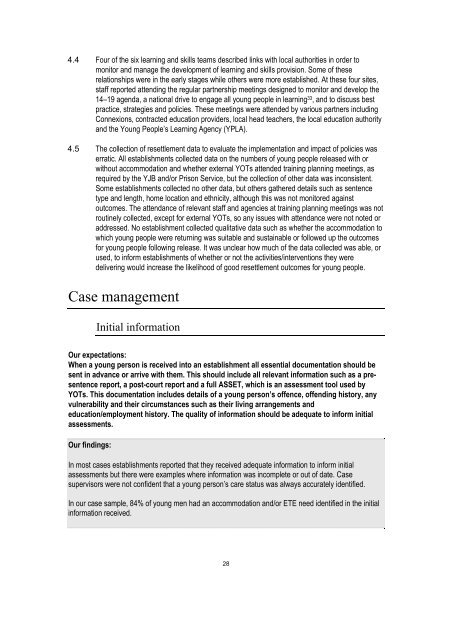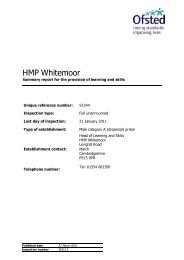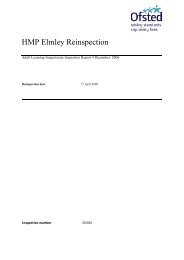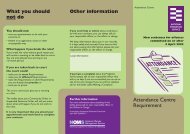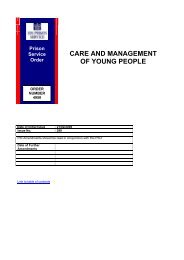Resettlement provision for children and young ... - Ministry of Justice
Resettlement provision for children and young ... - Ministry of Justice
Resettlement provision for children and young ... - Ministry of Justice
Create successful ePaper yourself
Turn your PDF publications into a flip-book with our unique Google optimized e-Paper software.
4.4 Four <strong>of</strong> the six learning <strong>and</strong> skills teams described links with local authorities in order to<br />
monitor <strong>and</strong> manage the development <strong>of</strong> learning <strong>and</strong> skills <strong>provision</strong>. Some <strong>of</strong> these<br />
relationships were in the early stages while others were more established. At these four sites,<br />
staff reported attending the regular partnership meetings designed to monitor <strong>and</strong> develop the<br />
14–19 agenda, a national drive to engage all <strong>young</strong> people in learning 33 , <strong>and</strong> to discuss best<br />
practice, strategies <strong>and</strong> policies. These meetings were attended by various partners including<br />
Connexions, contracted education providers, local head teachers, the local education authority<br />
<strong>and</strong> the Young People’s Learning Agency (YPLA).<br />
4.5 The collection <strong>of</strong> resettlement data to evaluate the implementation <strong>and</strong> impact <strong>of</strong> policies was<br />
erratic. All establishments collected data on the numbers <strong>of</strong> <strong>young</strong> people released with or<br />
without accommodation <strong>and</strong> whether external YOTs attended training planning meetings, as<br />
required by the YJB <strong>and</strong>/or Prison Service, but the collection <strong>of</strong> other data was inconsistent.<br />
Some establishments collected no other data, but others gathered details such as sentence<br />
type <strong>and</strong> length, home location <strong>and</strong> ethnicity, although this was not monitored against<br />
outcomes. The attendance <strong>of</strong> relevant staff <strong>and</strong> agencies at training planning meetings was not<br />
routinely collected, except <strong>for</strong> external YOTs, so any issues with attendance were not noted or<br />
addressed. No establishment collected qualitative data such as whether the accommodation to<br />
which <strong>young</strong> people were returning was suitable <strong>and</strong> sustainable or followed up the outcomes<br />
<strong>for</strong> <strong>young</strong> people following release. It was unclear how much <strong>of</strong> the data collected was able, or<br />
used, to in<strong>for</strong>m establishments <strong>of</strong> whether or not the activities/interventions they were<br />
delivering would increase the likelihood <strong>of</strong> good resettlement outcomes <strong>for</strong> <strong>young</strong> people.<br />
Case management<br />
Initial in<strong>for</strong>mation<br />
Our expectations:<br />
When a <strong>young</strong> person is received into an establishment all essential documentation should be<br />
sent in advance or arrive with them. This should include all relevant in<strong>for</strong>mation such as a presentence<br />
report, a post-court report <strong>and</strong> a full ASSET, which is an assessment tool used by<br />
YOTs. This documentation includes details <strong>of</strong> a <strong>young</strong> person’s <strong>of</strong>fence, <strong>of</strong>fending history, any<br />
vulnerability <strong>and</strong> their circumstances such as their living arrangements <strong>and</strong><br />
education/employment history. The quality <strong>of</strong> in<strong>for</strong>mation should be adequate to in<strong>for</strong>m initial<br />
assessments.<br />
Our findings:<br />
In most cases establishments reported that they received adequate in<strong>for</strong>mation to in<strong>for</strong>m initial<br />
assessments but there were examples where in<strong>for</strong>mation was incomplete or out <strong>of</strong> date. Case<br />
supervisors were not confident that a <strong>young</strong> person’s care status was always accurately identified.<br />
In our case sample, 84% <strong>of</strong> <strong>young</strong> men had an accommodation <strong>and</strong>/or ETE need identified in the initial<br />
in<strong>for</strong>mation received.<br />
28


